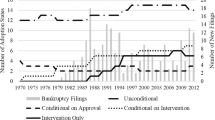Abstract
This paper provides an empirical analysis of the connection between budgetary procedures and deficits in Norwegian local governments. We argue that centralized budgetary procedures have an advantage in overcoming common-pool resource problems in the decision-making process and will lead to lower deficits. This hypothesis is tested on a panel data set of Norwegian local governments. The results add to the existing evidence of a negative connection between deficits and the degree of centralization of the budget process. Special emphasis is put on the problem with potential biased estimates resulting from endogeneity of the budgetary variables.
Similar content being viewed by others
References
Alesina A, Tabellini G (1990) A positive theory of fiscal deficits and government debt. Rev Econ Stud 57:403–414
Alt J, Lowry R (1994) Divided governments and budget deficits: evidence for the States. Am Pol Sci Rev 88:811–828
Barro R (1979) On the determination of public debt. J Pol Econ 87:940–947
Bohn H, Inman RP (1996) Balanced budget rules and public deficits: evidence from the U.S. States. NBER Work Pap 5533
Borge L-E (1995) Economic and political determinants of fee income in Norwegian local governments. Public Choice 83:353–373
Borge L-E (1996) The political economy of budget deficits: a study of Norwegian local governments. Department of Economics, Norwegian University of Science and Technology, Mimeo
Borge L-E, Tovmo P (2001) Balanced-budget-rules and the permanent-income hypothesis: an analysis of Norwegian local governments. Norwegian University of Science and Technology, Mimeo
Borrelli SA, Royed TJ (1995) Governments “Strength” and budget deficits in advanced democracies. Eur J Pol Res 28:225–260
Craig SG, Inman RP (1986). Education, welfare and the “new” federalism: state budgeting in a federalist public economy. In: Rosen HS (eds). Studies in state and local public finance. The University of Chicago Press, Chicago
Gravdahl HP, Hagen TP (1997) Ny Kommunelov, ny organisering? Organisasjon og arbeidsformer i kommuner og fylkeskommuner i 1996. NIBR-notat 1997:105
Hagen TP, Sørensen RJ (1996) Bargaining strength in budgetary processes: the impact of institutional procedures. J Theor Pol 8(1):41–63
Hallerberg M, von Hagen J (1999). Electoral institutions, cabinet negotiations, and budget deficits within the European Union. In: Poterba J, von Hagen J (eds). Fiscal institutions and fiscal performance. The University of Chicago Press, Chicago
Kalseth J, Rattsø J (1998) Political control of administrative spending: the case of local governments in Norway. Econ Pol 10(1):63–83
König T, Bräuninger T (1997) The constitutional choice of rules. An application of the absolute and relative power concepts to European legislation. MZES working paper ABII/17. Mannheim Center for European Social Research
Persson T, Tabellini G (2000) Political economics: explaining economic policy. MIT Press, Cambridge
Poterba J (1994) State responses to fiscal crisis: the effects of budgetary institutions and politics. J Pol Econ 102(4):799–821
Poterba J (1996) Do budget rules work? NBER Work Pap 5550
Rattsø J (1999) Fiscal adjustment with vertical fiscal imbalance: empirical evaluation of administrative fiscal federalism in Norway. Department of Economics, Norwegian University of Science and Technology, Mimeo
Roubini N, Sachs J (1989a) Political and economic determinants of budget deficits in the industrial democracies. Eur Econ Rev 33:903–938
Roubini N, Sachs J (1989b) Government spending and budget deficits in the industrial countries. Econ Pol 8:100–132
Shapley LS, Shubik M (1954) A method for evaluating the distribution of power in a committee system. Am Pol Sci Rev 48:787–792
Tovmo P (2003) The choice of budgetary institutions in Norwegian local governments. Department of Economics, Norwegian University of Science and Technology, Mimeo
Tsebelis G (2002) Veto players: how political institutions work. Princeton University Press, New Jersey
Velasco A (1999). A model of endogenous fiscal deficits and delayed fiscal reforms. In: Poterba J, von Hagen J (eds). Fiscal institutions and fiscal performance. The University of Chicago Press, Chicago
von Hagen J (1992) Budgeting procedures and fiscal performance in the European communities. Economic Paper 96, Commission of the European Communities
von Hagen J, Harden I (1995) Budget processes and commitment to fiscal discipline. Eur Econ Rev 39:771–779
Author information
Authors and Affiliations
Corresponding author
Rights and permissions
About this article
Cite this article
Tovmo, P. Budgetary Procedures and Deficits in Norwegian Local Governments. Economics of Governance 8, 37–49 (2007). https://doi.org/10.1007/s10101-006-0013-0
Received:
Accepted:
Published:
Issue Date:
DOI: https://doi.org/10.1007/s10101-006-0013-0




